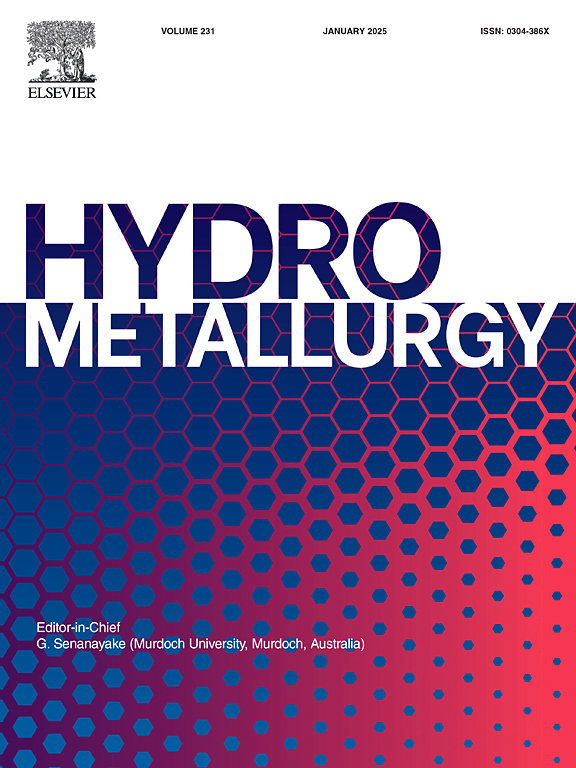Selective extraction of uranium from nitric acid leachate of Minjingu rock phosphate
IF 4.8
2区 材料科学
Q1 METALLURGY & METALLURGICAL ENGINEERING
引用次数: 0
Abstract
A sample of beneficiated rock phosphate from Minjingu Mine and Fertilizer Plant, Tanzania was analysed by energy-dispersive X-ray fluorescence (ED-XRF) spectroscopy and found to contain 15.8 % and 5.30 × 10−2 % w/w P2O5 and U, respectively. The U content of the same sample was estimated to be 3.70 × 10−2 % w/w when the digested mass was analysed by inductively coupled plasma mass spectrometry (ICP-MS). The rock was leached with three different mineral acids at 65–70 °C. The outlet liquid and solid streams were analysed by ICP-MS and ED-XRF, respectively. Maximum leaching of P2O5 and U occurred with 8.9 M HNO3. Their respective concentrations in the leachate were 6.69 % w/w (99.0 g L−1) and 1.80 × 10−2 % w/w (0.27 g L−1). The leachate also contained 1.90 × 10−2 % w/w (0.28 g L−1) rare earth elements (REEs). Selective extraction of U was attempted employing Di-2-ethyl hexyl phosphoric acid (D2EHPA) and Tri-butyl phosphate (TBP) as co-extractants. A 2-stage cross-current solvent extraction (10 g scale; 30 °C) with 1:6 mol ratio of D2EHPA:TBP (0.14 M total extractant concentration; 1:1 w/w organic/aqueous ratio) gave 81–89 % U extraction without co-extraction of REEs. The extraction of U increased to 95.6 % after four stages of solvent extraction but there was a noticeable co-extraction of Y beyond the first two stages. Production of fertilizers from U-free leachate is environmentally safer and the recovered U, in pure form, can be used for fuel production.

从 Minjingu 磷酸盐岩的硝酸浸出液中选择性提取铀
利用能量色散x射线荧光(eds - xrf)对坦桑尼亚Minjingu矿山和化肥厂的选矿磷矿样品进行了分析,发现P2O5和U的含量分别为15.8%和5.30 × 10−2% w/w。用电感耦合等离子体质谱法(ICP-MS)分析该样品的U含量为3.70 × 10−2% w/w。在65-70°C的温度下,用三种不同的矿物酸对岩石进行浸出。用ICP-MS和ED-XRF分别对出口液流和固体流进行分析。当HNO3浓度为8.9 M时,P2O5和U的浸出量最大。它们在渗滤液中的浓度分别为6.69% w/w (99.0 g L−1)和1.80 × 10−2% w/w (0.27 g L−1)。渗滤液中稀土元素含量为1.90 × 10−2% w/w (0.28 g L−1)。以二乙基己基磷酸(D2EHPA)和磷酸三丁酯(TBP)为共萃取剂,对U进行了选择性萃取。2级逆流溶剂萃取(10 g刻度;30°C), D2EHPA:TBP的摩尔比为1:6(萃取剂总浓度0.14 M;有机/水比为1:1),U萃取率为81 ~ 89%,无稀土共萃取。经过四段溶剂萃取,U的提取率提高到95.6%,但Y在前两段之后仍有明显的共萃取。从无铀的渗滤液中生产肥料对环境更安全,回收的纯铀可用于燃料生产。
本文章由计算机程序翻译,如有差异,请以英文原文为准。
求助全文
约1分钟内获得全文
求助全文
来源期刊

Hydrometallurgy
工程技术-冶金工程
CiteScore
9.50
自引率
6.40%
发文量
144
审稿时长
3.4 months
期刊介绍:
Hydrometallurgy aims to compile studies on novel processes, process design, chemistry, modelling, control, economics and interfaces between unit operations, and to provide a forum for discussions on case histories and operational difficulties.
Topics covered include: leaching of metal values by chemical reagents or bacterial action at ambient or elevated pressures and temperatures; separation of solids from leach liquors; removal of impurities and recovery of metal values by precipitation, ion exchange, solvent extraction, gaseous reduction, cementation, electro-winning and electro-refining; pre-treatment of ores by roasting or chemical treatments such as halogenation or reduction; recycling of reagents and treatment of effluents.
 求助内容:
求助内容: 应助结果提醒方式:
应助结果提醒方式:


